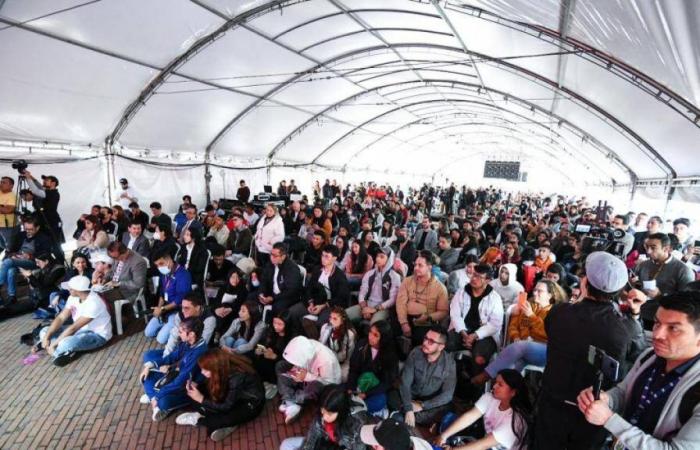Young people in Colombia They have a majority ideological affinity with the center and the right. Among this population, their inclination to the left is a minority. This can be seen in the results of the ninth youth perception study, carried out by the Universidad del Rosario and the survey firm Cifras y Conceptos, EL TIEMPO and the Hanns Seidel Foundation.
According to the criteria of
This is a survey carried out with a sample of 2,010 young people between 18 and 32 years old, habitual residents of the urban areas of 12 cities in the country, in different regions of the national territory, who were consulted about what they think, feel and want, within the framework of the current situation of the country.
Ideological affinity of young people.
Photo:TIME
It is a great statistical study of these firms at a time when the country is governed by a left-wing leader, Gustavo Petro, who arrived at the House of Nariño through the Historical Pact, on August 7, 2022.
The center remains the main preference with 54 percent (an increase compared to the eighth study, in October 2023, where it was 44 percent), while the option on the right fell from 37 to 28 percent. Left-wing ideology is at 18 percent, one point less than the last measurement that showed 17 percent.
“This has been happening paradoxically after the measurement in May 2021, when the events related to the social outbreak had just happened. Before this, more young people identified as left-wing than right-wing. This is due, in my view, to the fact that there is an ethereal and gaseous political center,” explains Carlos Charry, director of the doctorate and master’s degree in Social Studies at Rosario, who also participated in the methodological design of the measurement.
The assessment of the president’s management is completely divided. The favorability and unfavorability that young people express regarding President Gustavo Petro obtained the same percentage: 46 percent. The remaining 8 percent said they do not know or do not respond.
Gustavo Petro, president of Colombia
Photo:Presidency
For her part, the vice president’s unfavorability France Marquez It grew among youth, going from 46 percent in October 2023 to 53 percent in June 2024. The favorability of the person who also serves as Minister of Equality remained at 30 percent.
As for the social reformsthe majority of young people consider that both the national education law (59 percent), the labor reform (54 percent) and the pension reform (51 percent) will be approved by Congress.
This survey, however, was carried out among young people before this week, when Parliament experienced a race against the clock, and without the mobilizations of the teachers, grouped in Fecode, which shows their rejection of some aspects of the education reform.
Furthermore, the majority agree that the National Government should once again present a health reform (71 percent against 25). However, 40 percent of young people believe that the Government’s intervention in some EPS has made the quality of their service worse. 18 percent said it improved and 37 percent said it remains the same.
Who do they trust?
In terms of trust in institutions and figures, young people trust more in public universities (76 percent), the Registry (65 percent) and private universities (64 percent).
The opposite is true with digital influencers (84 percent distrust), political parties (81 percent distrust) and the media (73 percent distrust) and the Congress of the Republic (68 percent distrust).
The Magna Carta
When asking for the image they have of the Constitution56 percent said they had a favorable perception, 23 percent said it was unfavorable, and 21 percent indicated that they were indifferent.
On this occasion, some results were compared with the survey of this newspaper, the same university and the Konrad Adenauer Foundation carried out in 2021 to identify the perceptions of Colombians about the Constitution, within the framework of the letter’s thirtieth birthday. policy.
Young people highlight the public and peaceful demonstration.
Photo:iStock
“The results of this survey show us that The young people surveyed have a more favorable perception of the Constitution than the general population that was measured after 30 years of the Constitution in 2021”says Charry. And she remembers that “it was a quite complex year due to the issue of the social outbreak and that young people took center stage.”
Despite the positive perception of the Constitution in 2024, 51 percent of young people understand that the text must be complied with and 49 percent consider that it should be reformed.
On the other hand, The pollsters investigated the knowledge of young people in front of a national constituent assembly. At this point, 59 percent responded that they do not know its implications and the remaining 41 percent said they do.
For Cesar Caballeromanager of the polling firm Cifras y Conceptos, in general terms the interpretation of these results is that young people value the 1991 Constitution, they believe that some adjustments can be made to it – as in fact they have been doing – but the idea of a national constituent assembly does not seem to have support within this population.
“There is no atmosphere and no need is seen for a national constituent assembly. That is clear in these results. If you look at a single question, it seems that there is a division, but when you look at the three there is no environment for a general reform of the Constitution,” he comments.
Charry adds that “despite this lack of knowledge of the implications of what a national constituent assembly is, young people in Colombia today have a favorable image and want the Constitution to be fulfilled.”
The measurement is made at a time when the country’s political discussion has focused on whether or not to call a constituent assembly as President Petro proposed on March 15, in Cali, and on the legal channels that must be followed to summon her.
The weight of reality
Raúl Escobar, a researcher specialized in youth, assures that the factors that most influence the perception of young people regarding the political charter are closely related to the realities they live.
youth council
Photo:Presidency
“What I feel is that young people who see in their daily lives that there is education or work, trust the Constitution more. On the other hand, if the transformation of people’s lives does not exist, it is not in reality, because that means that young people can see themselves a little further from the Constitution of ’91,” he says.
Following the line of these observations, the measurement asked 173 people who claimed to have knowledge of the letter about the most positive aspects of the Constitution.
In that sense, Today’s youth highlights the right to public and peaceful demonstration (90 percent), the expansion in coverage and access to public services (89 percent) and equal rights and opportunities for men and women (88 percent).
Today’s youth highlights the right to public and peaceful demonstration (90 percent), the expansion of coverage and access to public services (89 percent) and equal rights and opportunities for men and women (88 percent). hundred).
Here a difference was marked between what young people highlighted most in 2024 compared to what the general population highlighted in 2021. The latter answered 93 percent that the most positive aspect of the Constitution is the guardianship action and the ease of exercising itfollowed by the right to freedom of religion (91 percent) and security as a service (87 percent).
“This shows that there is a different generational assessment of the issues. While for the general population, protection is the most important element of the Constitution of 91 for 93 percent, in the case of young people, the most important thing is the right to public and peaceful demonstration with 90 percent,” says Caballero. .
For political analyst María Lucía Jaimes, this assessment of youth is connected to the historical importance of the youth movement in all social struggles. “From the same movement of the seventh ballot in 1989 we see the importance of the organization of young people in a process. The student struggle that the Mane gathered in 2012 or the flags of the young people that were highly relevant in the 2019 national strike; which is why the right to protest, access to services and equal opportunities, which are directly related, continue to be important on the public agenda. If they can demonstrate, they can raise their voices to explain their positions and demand their rights,” she explains.
Now, the least positive points of the Magna Carta for young people are administrative decentralization (68 percent), the guarantee of the rights of the opposition and the mechanisms of citizen participation with 77 percent both.
According to Jaimes, this last aspect is related to the fact that “the voices of young people, mainly in the regions, are not taken into account. For example, in issues such as the construction of national youth public policy, it has been difficult to guarantee effective participation,” she says. Hence the importance of listening to young people to know which country they want.
Follow the forum of this survey in EL TIEMPO
On June 20, from 2 pm, the forum ‘What do young people in Colombia think, feel and want?’ will take place at the EL TIEMPO Editorial House. The results of the gender module will be presented. Follow him on YouTube and ELTIEMPO.COM.
Data sheet
Objective: carry out the ninth measurement of young people in Colombia to investigate the perception of what they think, feel and want, within the framework of the current situation in the country. Natural or legal person who commissioned it and source of financing: Universidad del Rosario. Legal entity that carried out the study: Cifras y Conceptos SA Geographic scope of study: the urban area of Medellín, Barranquilla, Bogotá, Montería, Quibdó, Pasto, San José de Cúcuta, Pereira, Bucaramanga, Cali, Arauca and San Andrés. Target population: people between 18 and 32 years of age habitual residents of the municipalities that make up the geographical area of study. Procedure used for the selection of the units: the premises for the selection of the observation units correspond to those of a statistical probabilistic sampling design, by stages, stratified with an area framework. The area framework corresponds to the available cartographic inventory. Source: Dane based on the latest National Population Census and population projections to date. Sample size and margin of error: 2010 surveys. Margin of error: for the aggregate of municipalities 4.6%, with a reliability of 95% for phenomena observed in the population with a minimum frequency of 20%. Universe represented: an estimated universe of 4,280,000 young people between 18 and 32 years old. Weighting method: the sample data are calibrated to the population structures of the study universe using the variables of geographical area, age groups, sex and socioeconomic level of the interviewee’s home. Field work dates: May 10 to 28, 2024. Technique used for sample selection: in-person household survey with structured questionnaire. Number of interviewers and supervisors: 76 interviewers, 11 supervisors, 1 coordinator. Project manager: Yennifer Pérez. Statistician: Miguel Ángel León. Form questions: see attached form. Supervision of interviewers: direct supervision: 33%. Recontact: 23%. Stages/activities of the research process that, partially or totally, have been subcontracted: supervision and application of surveys in the field. Note: our suppliers (strategic allies with external links) participated, who have been previously trained and supervised by the firm’s internal staff.
JUAN PABLO PENAGOS RAMÍREZ
Political Journalist






